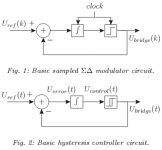Hi all,
I've been wondering, what is the real difference between self oscillating class d amps and sigma delta ones?
Except than the sigma delta are clocked systems, while the other are "free running", they look quite close to me.
Both are very different than the "comparator+triangle" topology. Comparator+triangle have a clearly defined switching frequency, with a spectrum from a natural PWM. While the output spectrum (pre-filter, of course) of the SD and SO don't show a clear frequency (switching frequ depends on the input signal's value)
Any opinions?
I've been wondering, what is the real difference between self oscillating class d amps and sigma delta ones?
Except than the sigma delta are clocked systems, while the other are "free running", they look quite close to me.
Both are very different than the "comparator+triangle" topology. Comparator+triangle have a clearly defined switching frequency, with a spectrum from a natural PWM. While the output spectrum (pre-filter, of course) of the SD and SO don't show a clear frequency (switching frequ depends on the input signal's value)
Any opinions?
There're some differences and some similarities
The real question is which one is sonically "better", and even that depends on implementation.
Just like the tube audiophiles think their relative high distortion amp is better sounding than the zero THD Halcro because of low feedback, there's no end to this kind of subjectivism. Hence so many brands of audio gears, unlike CPU or cars.
The real question is which one is sonically "better", and even that depends on implementation.
Just like the tube audiophiles think their relative high distortion amp is better sounding than the zero THD Halcro because of low feedback, there's no end to this kind of subjectivism. Hence so many brands of audio gears, unlike CPU or cars.
Bricolo said:Hi all,
I've been wondering, what is the real difference between self oscillating class d amps and sigma delta ones?
Except than the sigma delta are clocked systems, while the other are "free running", they look quite close to me.
Yes, that's exactly what makes the difference, and it's a huge one from the signal theory point of view: the switching instants in the sigma-delta are discretely defined; this has an impact on the output spectrum and distorsion residues: the spectrum in the case of the s.d. will show strong concentrations of energy at multiple and submultiples of the clock frequency, whereas the self-oscillating will spread the energy much more evenly, with increased levels only present at multiples of the modulating frequency.
If you compare the two methods, assuming equivalent hardware (comparator speed, etc), the self oscillating will come out as a big winner: to achieve a similar dynamic, the s.d. has to trade speed for resolution, and if the speed is similar, the resolution will be worse.
It is one of the difficulty of making a completely digital amplifier: in order to get good results, you need an extremely high primary clock frequency.
And I'm pretty sure the self-oscillating will sound better than s.d. in most cases: s.d. generates non-harmonically related distorsion products which sound very nasty, even at very low levels; and this is not golden-ears subjectivism: if you try it on an on-line simulator, you will distinctly notice the hoarse, raspy sound of s.d., even at moderately high sampling rates.
LV
- Status
- This old topic is closed. If you want to reopen this topic, contact a moderator using the "Report Post" button.
- Home
- Amplifiers
- Class D
- Self oscillating vs sigma delta, what's the difference?
